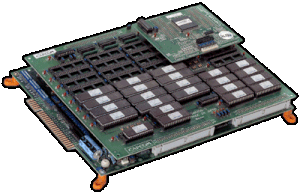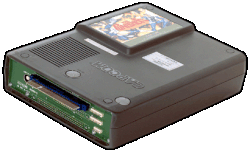CP System

A CP System board
|
|
| Manufacturer | Capcom |
|---|---|
| Release date | July 1988 |
| CPU | Motorola 68000 (@ 10 MHz) |
| Display | Raster, 384 × 224 pixels (Horizontal), 4096 colors |
| Input | 8-way joystick, from 3 to 6 buttons |

A CPS-1.5 board
|
|
| Manufacturer | Capcom |
|---|---|
| Release date | December 1992 |
| CPU | Motorola 68000 (@ 10 MHz) |
| Display | Raster, 384 × 224 pixels (Horizontal), 3072 colors |
| Input | 8-way joystick, from 3 to 6 buttons |
The CP System (CPシステム shīpī shisutemu?) or CPS is an arcade system board developed by Capcom that ran game software stored on removable ROM cartridges. More than two dozen arcade titles were released for CPS-1, before Capcom shifted game development over to its successor, the CP System II.
Capcom's Street Fighter II series is perhaps the best known franchise within the CPS game library. The first three titles in the series (The World Warrior, Champion Edition and Hyper Fighting) were all developed on CPS-1 and highly successful.
After a number of arcade game boards designed to run only one game, Capcom embarked upon a project to produce a system board that could be used to run multiple games, in order to reduce hardware costs and make the system more appealing to arcade operators.
The system was plagued by many bootleg versions of its games. In particular, there were so many bootleg versions of Street Fighter II, that they were more common in some countries than the official version. This problem was virtually eliminated by Capcom in the later CP System II.
The CP System hardware was also utilized in Capcom's unsuccessful attempt at home console market penetration, the CPS Changer, a domestic version of the CP System similar to the Neo-Geo AES.
A year before releasing the CP System II, Capcom released an enhanced version of the original CP System dubbed the CP System Dash, which had some features that would later be used in the CP System II, such as the Q-Sound chips.
The CP System Dash boards have four interlocking PCBs and are contained in gray plastic boxes. To combat piracy, "suicide batteries" were implemented, which power the volatile RAM which contained the manual configuration of the display hardware registers, as well as the priorities registers. The CPS-1 Dash 68000 code is not encrypted at all. If the batteries' voltage should drop below +2V, the registers manually defined in factory by Capcom in RAM would be lost, and the PPU would no longer have access to the hardware specific register set on the game used, rendering the game inoperable, and necessitating the operator sending the board to Capcom to be fixed, at his own expense. Unlike the CP System II, CP System Dash sound ROMs were encrypted using "Kabuki" Z80s.
...
Wikipedia
